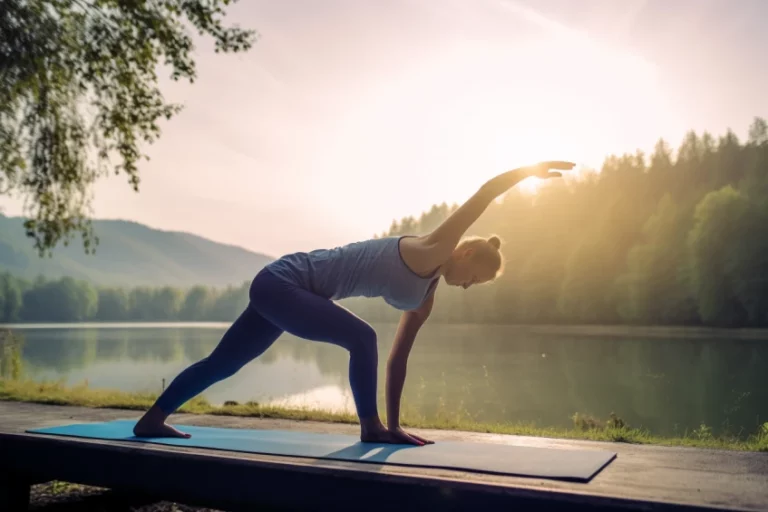8 Best Ab Exercises For Beginners

A strong core is essential for overall fitness and well-being. This article looks into the realm of abdominal exercises, providing a comprehensive guide for beginners and advanced fitness enthusiasts alike.
We explore the top five exercises for beginners, advanced workouts for core strengthening, tips to enhance results, and common mistakes to avoid.
Join us as we embark on this journey to enhance abdominal strength and improve your fitness.
High Protein Recipe Pack (eBook)
Unleash Your Inner Chef with Our High-Protein Recipe Collection – Featuring 43 Nutritious and Delicious Recipes
Understanding the Importance of Abdominal Strength
The importance of abdominal strength cannot be overstated, as it plays a pivotal role in overall body stability and posture.
Picture your body as a tree; the trunk, or core, must be sturdy to keep the whole tree upright. That’s where Abdominal Strength for Posture Improvement comes in.
Think of it as the foundation of a house; if the foundation is weak, the entire structure is at risk. Similarly, weak abdominal muscles can lead to poor posture and even health problems like back pain.
Hence, the importance of Core Stability in maintaining good health and preventing injuries. Just as a house needs a strong foundation, your body needs a strong core.
Top 8 Ab Exercises for Beginners
For those just starting their fitness journey, there are eight core strengthening activities that are ideal for beginners.
These beginner-friendly exercises not only target your abs, but also play a pivotal role in improving your posture, akin to the support a well-built foundation provides to a house.
1. Bicycle Crunches
The Bicycle Crunches, often referred to as “Air Bicycles,” are believed to have been inspired by the motion of pedaling a bicycle. Over time, fitness enthusiasts recognized its effectiveness in targeting the obliques and incorporated it into core workouts.
How to Do It:
Muscles Targeted: Rectus abdominis, obliques, and hip flexors.
Benefits: Engages multiple muscle groups simultaneously, targeting the obliques with the twisting motion and the hip flexors with the leg movement.
2. Captain’s Chair Leg Raises
The Captain’s Chair exercise is named after the equipment used, which resembles a chair without a seat. It has been a staple in gym settings for decades, known for its effectiveness in isolating the lower abs.
How to Do It:
Muscles Targeted: Lower rectus abdominis and hip flexors.
Benefits: Isolates the lower abdominal muscles and challenges grip strength.
3. Crunches on an Exercise Ball
The use of exercise balls in fitness routines dates back to the 1960s. The Swiss Ball, as it was originally known, was used in physiotherapy before its benefits for core stabilization were recognized in athletic training.
How to Do It:
- Sit on an exercise ball and roll down until your lower back is supported by the ball.
- Place your hands behind your head.
- Perform traditional crunches, lifting your upper body towards the ceiling.
Muscles Targeted: Rectus abdominis and obliques.
Benefits: Enhances muscle activation due to the unstable surface of the ball.
4. Tabletop Crunch and Reach
The Tabletop position is commonly used in Pilates and yoga practices. The combination of this position with a crunch motion is a more recent adaptation to intensify core engagement.
How to Do It:
Muscles Targeted: Rectus abdominis, obliques, and hip flexors.
Benefits: Combines traditional crunch with leg movement for comprehensive abdominal engagement.
5. Crunch Heel Touches
This exercise is a variation of the traditional crunch, with added lateral movement to target the obliques. Its origin is likely rooted in modern fitness routines aiming for comprehensive core engagement.
How to Do It:
Muscles Targeted: Obliques.
Benefits: Specifically targets the obliques, promoting a well-defined waistline.
6. Forearm Plank Walkouts
The plank is an ancient exercise, with depictions found in historical art and texts. The walkout variation is a modern twist, adding dynamic movement to the static plank for increased challenge.
How to Do It:
Muscles Targeted: Rectus abdominis, obliques, and lower back.
Benefits: Challenges the core with dynamic movement.
7. Dragon Flag
Popularized by martial artist and actor Bruce Lee, the Dragon Flag is a testament to core strength. Its name is inspired by Lee’s nickname, “Little Dragon.”
How to Do It:
Muscles Targeted: Rectus abdominis, obliques, and lower back.
Benefits: Engages the entire core for a comprehensive workout.
8. Jackknife
The Jackknife is named for its resemblance to a folding pocket knife. It’s a classic calisthenics move, emphasizing coordination and core strength.
How to Do It:
Muscles Targeted: Rectus abdominis and hip flexors.
Benefits: Targets both upper and lower abs with a full-range motion.
Think of these exercises as the basic tools in a handyman’s kit, each serving a specific purpose in your overall fitness goal. Start your journey with these and gradually add more advanced workouts as your strength builds.
Advanced Ab Workouts for Core Strengthening
Moving beyond the initial stages of core strengthening, individuals often seek to elevate their routine with more complex workouts to further enhance muscle definition and endurance. Here we’ll explore advanced ab workouts, their effectiveness, and how they compare to Pilates and traditional workouts.
When considering ab equipment effectiveness, the table below provides a quick comparison:
| Equipment | Muscle Targeted | Effectiveness |
|---|---|---|
| Ab Roller | Entire core | High |
| Pull up bar | Lower abs | Medium |
| Stability Ball | Entire core | High |
| Medicine Ball | Entire core | Medium |
| Power Tower | Upper abs | High |
In the battle of Pilates versus traditional workouts, the former offers a more balanced, full-body approach, while the latter focuses more on targeted muscle groups. Both, however, can effectively strengthen the core.
Tips to Enhance Your Ab Workout Results
Optimizing your core strengthening routine requires an understanding of certain strategies that can significantly enhance the results of your workout regimen.
Proper Breathing Techniques and the use of specific Ab Workout Equipment play critical roles in this process.
Incorporating these strategies into your routine can lead to significant improvements in your core strength and overall fitness.
Common Mistakes to Avoid While Doing Ab Exercises
Common mistakes during core strengthening workouts can hinder your progress and potentially lead to injuries, thus it is crucial to identify and avoid them.
Incorrect formations, for instance, undermine the effectiveness of the exercise. Imagine using a wrench incorrectly; you’d exert more effort but achieve less. Similarly, performing ab exercises with improper form decreases their efficiency and increases the risk of strain.
Another common blunder is neglecting proper breathing techniques. Breathing is not merely a life-sustaining process, but in the context of workouts, it’s akin to oiling a machine for smooth operation. Holding your breath or breathing irregularly during exercise can lead to dizziness and exhaustion.
Thus, practicing correct formations and breathing techniques is paramount to ensure a safe and effective workout.
Conclusion
In conclusion, maintaining abdominal strength is pivotal for overall body health. Incorporating basic and advanced ab exercises allows for improved core power and stability.
Enhancements in workout results can be achieved through proper form, consistency, and diet. Avoiding common mistakes such as improper technique and overtraining is essential.
In essence, a well-rounded, correctly executed, and consistent ab workout regime is integral to achieving optimal core strength.
Feeling Peckish? We Got You.
Frequently Asked Questions
References
- Healthy Breakfast Recipes - September 21, 2023
- Health Habit to Ditch Immediately - September 20, 2023
- Grass Fed Beef - September 20, 2023










